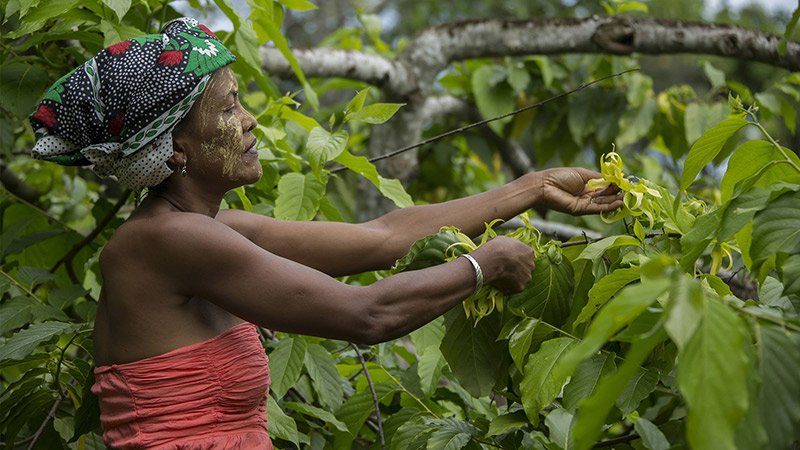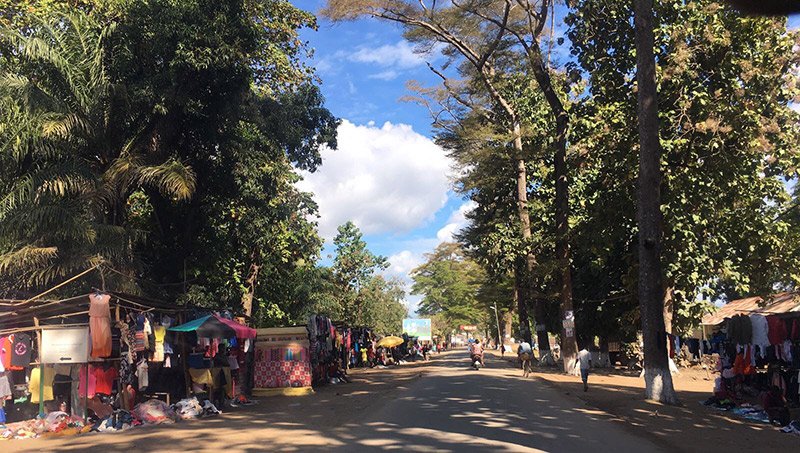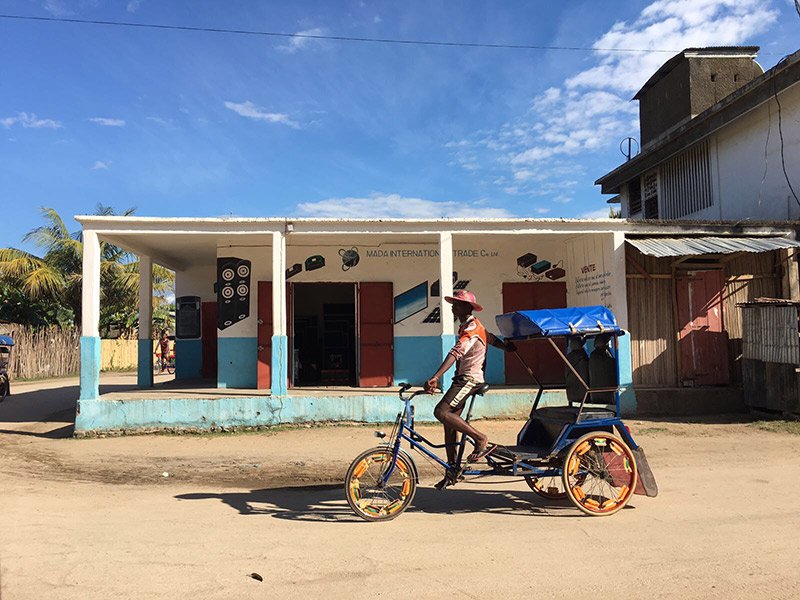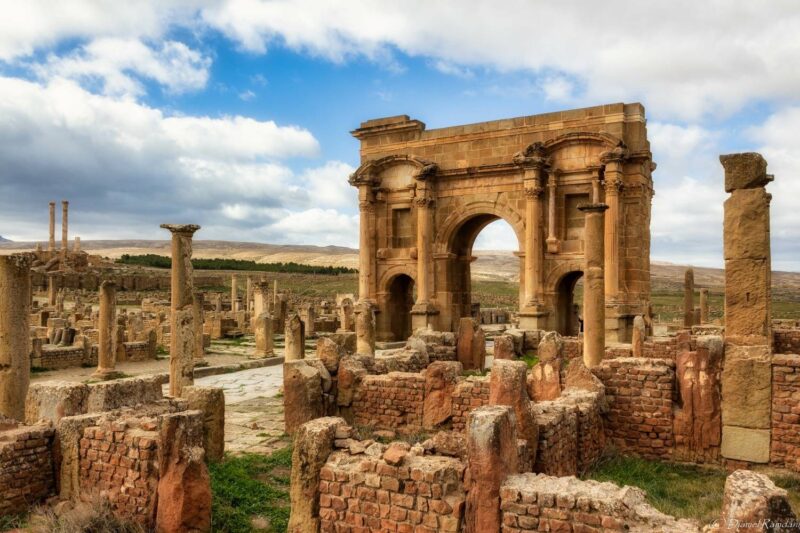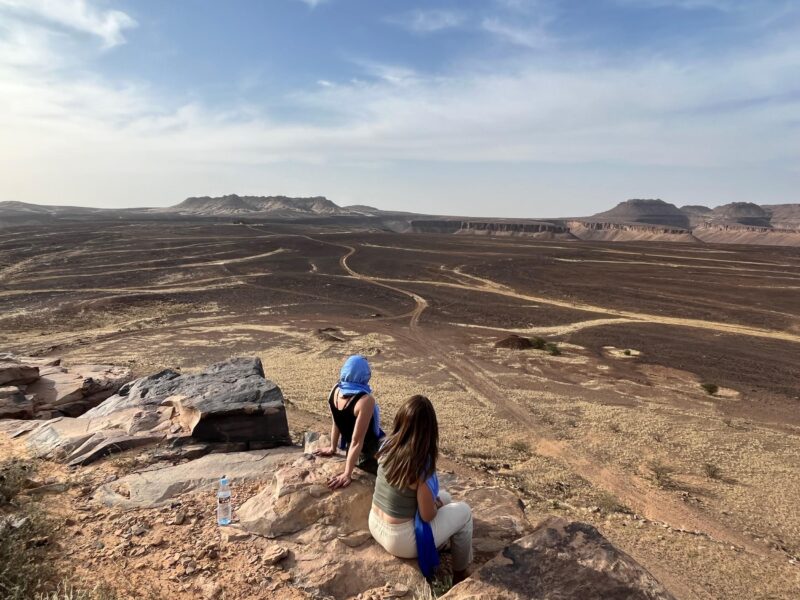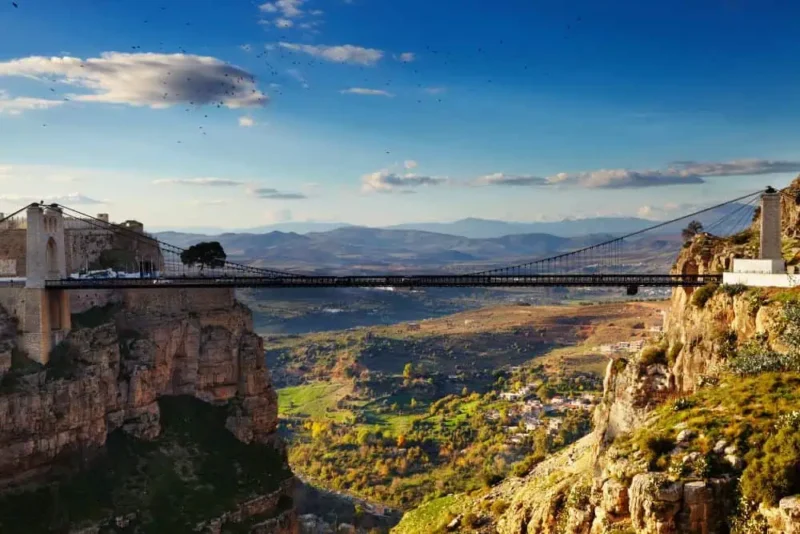| Tour Code | Start | End | Trip Status | Pricing Per person |
|---|---|---|---|---|
| MUT/280526 |
May 28, 2026
Thursday |
Jun 19, 2026
Friday |
Guaranteed |
£4,395.00
Single Room Supplement: £815.00 |
| MUT/130826 |
Aug 13, 2026
Thursday |
Sep 04, 2026
Friday |
Guaranteed |
£4,395.00
Single Room Supplement: £815.00 |
| MUT/011026 |
Oct 01, 2026
Thursday |
Oct 23, 2026
Friday |
Guaranteed |
£4,395.00
Single Room Supplement: £815.00 |
| MUT/270527 |
May 27, 2027
Thursday |
Jun 18, 2027
Friday |
Guaranteed |
£4,395.00
Single Room Supplement: £815.00 |
| MUT/120827 |
Aug 12, 2027
Thursday |
Sep 03, 2027
Friday |
Guaranteed |
£4,395.00
Single Room Supplement: £815.00 |
| MUT/300927 |
Sep 30, 2027
Thursday |
Oct 22, 2027
Friday |
Guaranteed |
£4,395.00
Single Room Supplement: £815.00 |
Wild Madagascar
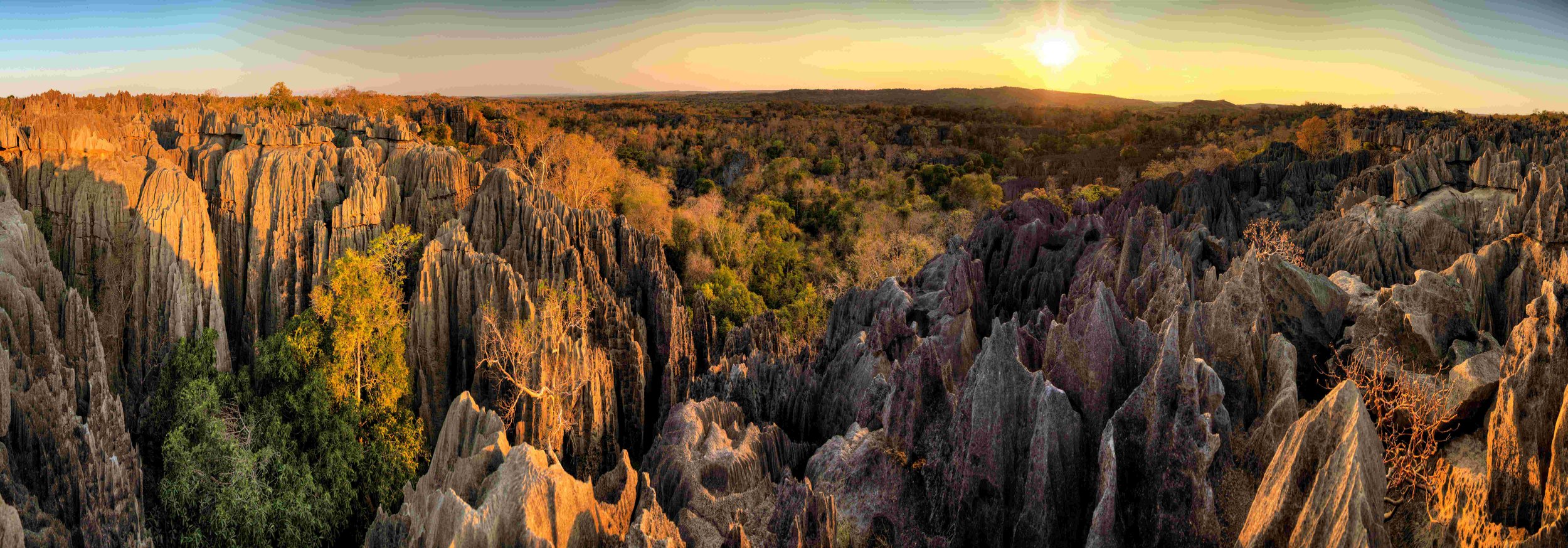
The island of Madagascar occupies a unique place, both culturally and geographically, within Africa. Separated from the mainland millions of years ago, its fauna has developed very differently from the rest of the continent’s wildlife, and it is home to countless species found nowhere else on earth. Its people are an intriguing mix of Malay and African ancestry, with complex patterns of beliefs and an unusual history. On this off the beaten track adventure we explore this enigmatic and alluring land. Our journey takes us West on an exciting navigation along the Tsiribihina River followed by a visit to Kirindy Reserve with its semi-dry western tropical forest, home to the “fossa”. We then travel the coastal track from Morondava to Tulear with its stunning scenery of baobabs, thorny bushes, and magically pristine white sandy beaches, home to the Mikea, a primitive bee-hunting tribe that have very little contact with Westerners – without a doubt one of the cultural highlights of the tour. Heading inland again, another truly memorable high spot greets us: the little frequented Andringitra National Park where we hike along the spectacular Tsaranoro Valley. We then enter the culturally rich and diverse Central Highlands before the tour ends in the capital Antananarivo. The tour can then be extended with a visit to the Anjozorobe Forest corridor where we explore its delicate and stunning tropical rainforest, rich in unique wildlife: sundry species of lemur, including the beautiful Indri, chameleons, and a multitude of reptiles. Madagascar is unlike anywhere else on earth – join us to experience its diverse charms on a trip that will challenge what you thought you knew about Africa.
Arrival and departure transfers
Overland transport throughout with professional driver
Domestic flights as shown in the itinerary
All accommodation
Services of English-speaking guide / tour leader
Meals as listed B – Breakfast L – Lunch D – Dinner
Entrance fees for sites listed as part of the itinerary
International flights (contact us for expert advice and a quote)
Any airport taxes (except when included with domestic flights)
Travel Insurance
Visa – To be obtained in advance
Drinks
Items of personal nature
Tips (Discretionary)
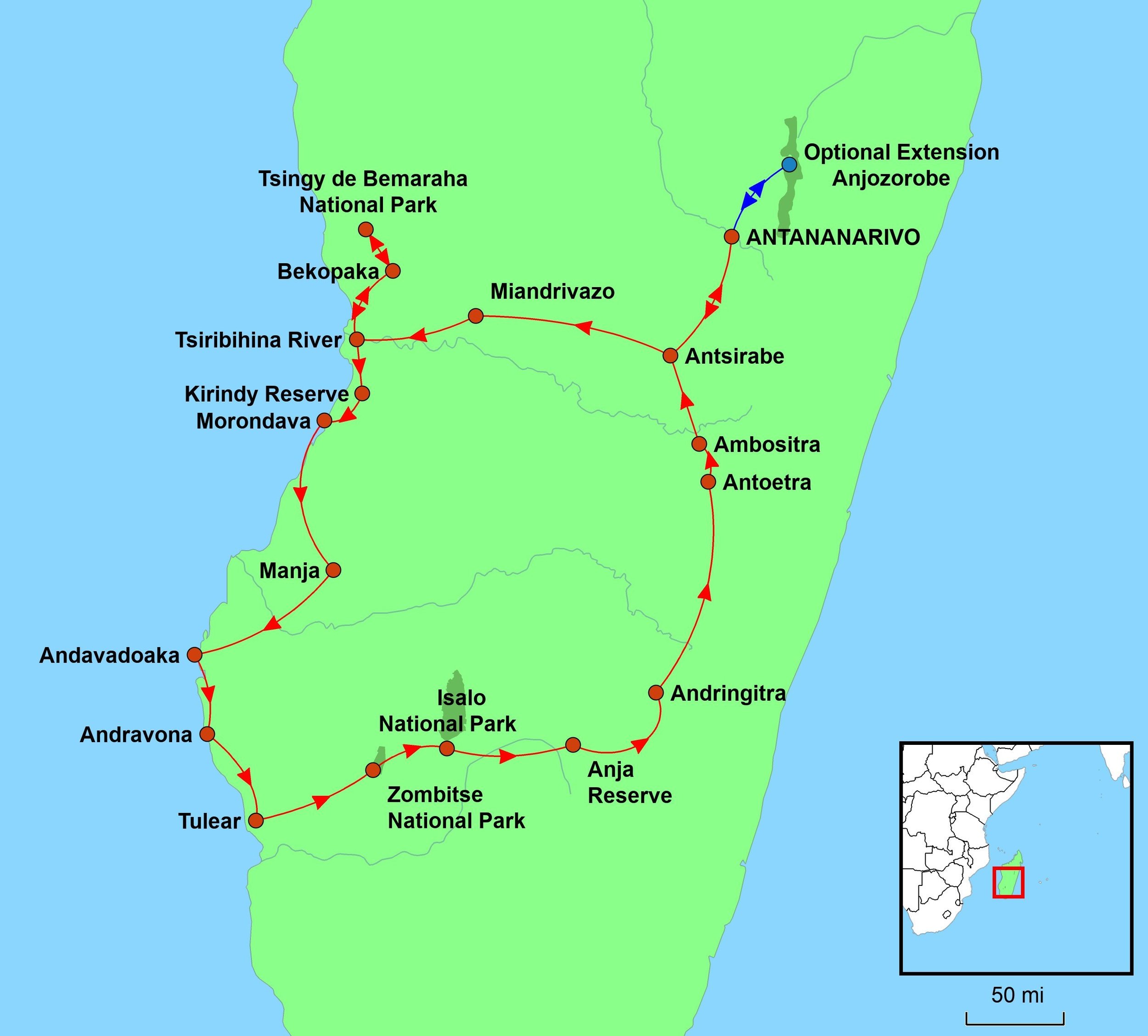
This 23-day Madagascar adventure combines cultural immersion, wildlife exploration, and stunning landscapes. Starting in Antananarivo, you’ll visit the capital and travel through Antsirabe, a European-styled city, and explore the UNESCO-listed Tsingy de Bemaraha National Park. The journey continues to coastal regions like Andavadoaka, known for its baobab trees and marine life, and ends with visits to Isalo National Park, Andringitra’s mountain vistas, and the Zafimaniry tribe. Highlights include hikes in Isalo’s sandstone formations, encounters with lemurs in Anja Reserve, and a cultural day with the Zafimaniry. The trip concludes with a return to Antananarivo for departure. Expect beautiful coastal views, wildlife sightings, and cultural experiences, with ample time to relax. This only scratches the surface keep scrolling or download the Dossier for more information.
Tsingy de Bemaraha National Park
Explore the stunning limestone formations, hiking through Grand and Petit Tsingy circuits with incredible vistas and unique wildlife encounters.
Kirindy Reserve
Experience rare wildlife on night walks, including the elusive fossa and giant jumping rat, and enjoy the vibrant ecosystems in this forest reserve.
Andavadoaka & Andravona
Discover Madagascar’s coastal beauty with pristine beaches, baobabs, and traditional fishing villages, offering unique cultural and natural experiences.
Isalo National Park
Trek through dramatic sandstone formations and canyons, with opportunities for wildlife spotting and breathtaking panoramic views, including the famous Fenetre de l'Isalo.
Zafimaniry Tribe
Immerse in the culture of the Zafimaniry tribe, known for their exceptional woodcraft and sustainable forest practices, classified as UNESCO world heritage.
Download the Information Pack
To download the tour full dossier, which includes a complete day-by-day itinerary breakdown and detailed tour information, fill in the details below.

Foreign Office Travel Warnings Before booking your tour, please familiarise yourself with the country specific information provided by the UK’s Foreign, Commonwealth and Development Office (FCDO) – www.gov.uk/foreign-travel-advice. This includes important information such as latest immigration requirements, and details of any travel advisories. We constantly monitor the advice posted by the FCDO. In particular we will always advise clients of any travel warnings. At present there are no warnings against travel to the parts of Madagascar that we visit on this tour. Please feel free to contact us should you have any specific concerns or would like to know in detail what measures are being taken to ensure visits remain trouble free and without incident. It should be noted that this information applies to British citizens. Other nationals are asked to check the current position of their respective government. Visa Information At the time of writing British, US and Australian nationals require a visa for a tourist visit to Madagascar if they are staying for 15 days or longer. For further details please visit the applicable website shown below. British Nationals – www.gov.uk/foreign-travel-advice US Nationals – travel.state.gov/content/travel/en/international-travel.html Australian Nationals – www.smartraveller.gov.au Other nationals should check the latest requirements with the authorities in their home country, or with the destination’s nearest embassy or consulate. Should you require any documentation to support a visa application, such as a letter of invitation, upon request this will be provided by Undiscovered Destinations after receipt of your balance payment. As it is the travellers’ responsibility to ensure that they meet all entry requirements it is essential that you check the rules and any other conditions at the time of booking and again when making your balance payment. In addition, we would strongly advise that you make a final check around two weeks before your arrival. This is important as requirements can change at short notice. Undiscovered Destinations, when possible, will provide guidance about entry rules, but in the first instance please contact the relevant authorities, including the applicable embassy or consulate for assistance. Passports It is your responsibility to ensure that you are in possession of a full passport, valid for at least six months after the date of return to your country. We strongly advise that your passport contains a minimum of two blank pages, as this may be a requirement of the local immigration authorities. In addition, certain countries will stipulate that the two blank pages are opposite each other. If you are unable to meet these requirements, you may be refused boarding by your airline or denied entry by the immigration authorities. For specific information about the requirements for your destination please check with the country’s embassy or consulate. Alternatively, UK citizens can visit www.gov.uk/foreign-travel-advice. Vaccinations & Protection As with travel to most parts of Africa, we strongly recommend that you contact your doctor’s surgery or a specialist travel clinic for up-to-date information, advice, and the necessary vaccinations. For a visit of less than one month, almost certainly you will be advised to have immunisations against the following: Diphtheria and Tetanus, Hepatitis A, Typhoid, Meningitis. The use of a DEET-containing insect repellent is highly recommended. The legal status and regulation of some medicines prescribed or purchased in your home country can be different in other countries. If you’re travelling with prescription or over-the-counter medicine, read this guidance from NaTHNaC on best practice when travelling with medicines. For further information on the legal status of a specific medicine, you’ll need to contact the embassy, high commission or consulate of the country or territory you’re travelling to. Travel Insurance It is a condition of booking with Undiscovered Destinations that you have adequate valid travel insurance. It is your responsibility to arrange appropriate travel insurance and ensure you have read and understood the full terms and conditions of your travel insurance policy to ensure that you are covered for all activities you intend to undertake whilst on the tour, including all optional activities. Your Insurance Policy must fully cover you for medical expenses (including cover for Covid-19 conditions) and emergency repatriation to your home country and be valid for the entire duration of your holiday. Local Conditions When travelling to our destinations, many of which are underdeveloped and untouristed by mainstream tourism, a good deal of patience and a sense of humour is an important attribute. This will help you to cope with problems such as ageing or poor infrastructure and when maintenance may not be as high as we would always like. The choice of appropriate accommodation in some towns and cities (particularly the smaller places) can be limited, and standards of both service and maintenance can be less than polished. Guides and other service providers in some of our destinations do not always have the decades of collective practice and experience that their counterparts in more developed countries can draw upon. Although we will always try and resolve any issues as quickly as possible, on occasions there may be some shortcomings which no matter how hard we try will be unavoidable.
